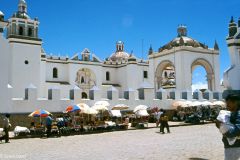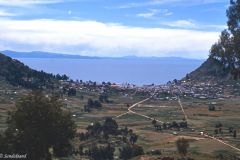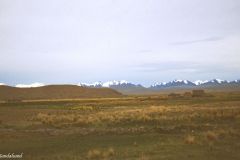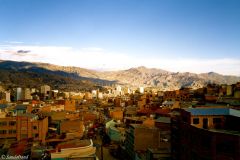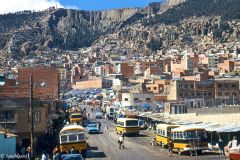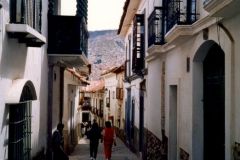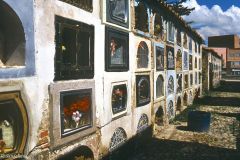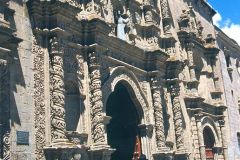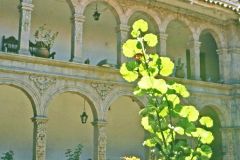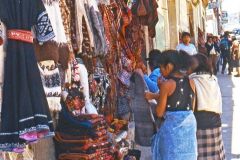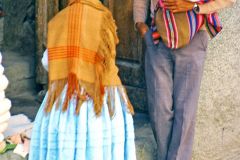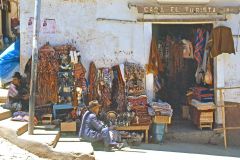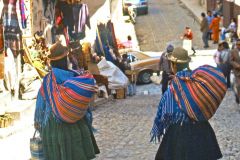This is my story about the trip to La Paz from the north, across the Bolivian Altiplano to the city of presumable peace.
This article is part of a travelogue from of a five month journey in 1987-1988 to several countries in South America: Brazil, Peru, Ecuador, Bolivia, Chile.
(A remark at the time of blogging (2013): This is the story of a five month journey to South America in 1987-88. My girlfriend Bo and I visited five countries on the continent, from Brazil in the east to Peru in the west, from Ecuador in the north to Bolivia and finally Chile in the south. This is the first chapter from our almost fourteen days in Bolivia. My story is a transcript from my diary at the time. I have added nothing and omitted very little. The currency in Bolivia was called bolivianos and was exchanged at a rate of 2.2 bolivianos to a US$.)
Monday 28.12.1987, Puno – La Paz
Leaving Peru
In Puno, Peru we had bought bus tickets from a company unable to fill up their own bus and consequently we were put on a bus from another company (Panamericana). The trip to Yunguyo went quite smoothly and we passed a few Altiplano villages and towns along Lake Titicaca.
In Yunguyo we bought bolivianos for our remaining 2,200 Peruvian intis (roughly 25 USD) at a rather poor exchange rate. We then sat down in the bus once more, on good seats but on gradually worse roads, and left for the border control posts.
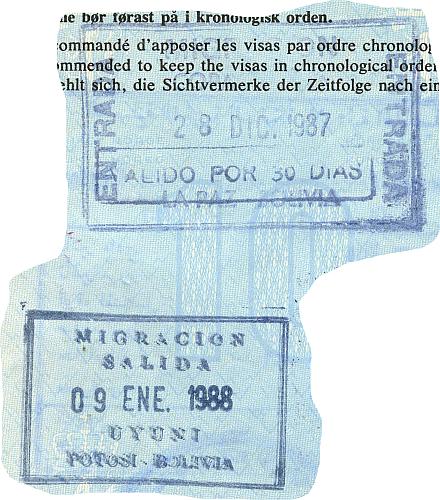
Bolivia entry and exit stamps in my passport
Copacabana, the Altiplano and finally La Paz
In the Bolivian town of Copacabana – which actually has a long beach on the Titicaca, but who wants to swim there? – we routinely only received a thirty day visa stamp. Then we had lunch. There we had our first encounter we Bolivian prices, which we had heard was on an uncomfortably high level. We paid 6 bolivianos (2.7 USD) each for an ordinary lunch, terrible.
In Copacabana we had to change to a Bolivian minibus. Overbooking caused a mess threatening two Swiss of being thrown out. They stood firm however and the company man had to bite his teeth and give up. Later they were secured seats on a fast minibus and was satisfied with that.
A bit later we took a boat over a strait, primitive like in the Amazon, and we turned south over the high plains of Bolivia towards La Paz with the snow covered Cordillera in the east – beautiful.
The bus stopped outside a hotel in central La Paz after a journey of ten hours (as opposed the promised eight) and one flat tire. As it was dark and a long way to the cheap hotels we were aiming at, we just checked into the hotel next to the bus stop.
- Hotel Sagárnaga. It is located in the street carrying the same name, central, 15 bolivianos (6.8 USD) for a double without private bath but with a quite good standard. Map.
In the company of an Aussie couple we went looking for a cheap dinner restaurant. Shocking prices: 5-7 bolivianos (almost three dollars).
Tuesday 29.12.1987, La Paz
For almost seven dollars a night I did not sleep well and because of this stiff price we went looking for another hotel – but to no avail. The hotels our South American Handbook recommended (Neumann, Rosario and Max Paredes) were just as expensive as our hotel and of equal standard, while the Los Angeles was cheap and horrible. So we are staying.
There are many exciting street markets nearby and La Paz seems pleasant actually. It was nice to find letters and a package with Christmas gifts and cookies from home (upon paying 2 bolivianos). The Christmas cookies were intact and tasted excellent – thanks to my mother for that!
We went for a long walk until we found a relocated tourist information office. We exchanged travellers’ cheques in one of the many exchange bureaus – there is not much of a black market here.
Bo tried to a call a doctor without success.
Wednesday 30.12.1987, La Paz
We took bus no. 11 (0.25 $b, 30 min) from our street to the Moon Valley (Valle de la Luna) and walked up the road past strange rock formations and different colours in the hills around – limestone mostly.
Back in the city I tried on a number of alpaca-sweaters and bought one at the end for 18 $b (8 $US).
Bo went to a doctor who was skilled and told her to leave a stool sample in a laboratory and return on Monday.
The train we have been thinking of taking to Antofagasta in Chile, only runs once a week, Fridays. As Bo’s appointment at the doctor leaves us no opportunity to visit other parts in Bolivia, we decided to remain in the country a week longer than initially planned.
Thursday 31.12.1987, La Paz
We walked around town, but the museums we had thought of visiting, were closed. We went uphill on the streets where the Indians had their stalls selling all sort of things. Calle Jaen is a nice little street in old colonial style.
When we in the evening went looking for a slightly upscale restaurant we found a number of restaurants closed, but we got ourselves a good pizza in Hotel Gloria in an almost empty cafeteria.
The rain was pouring, but when we had enjoyed Chilean champagne and mother’s cookies in our room and went out to send up our fireworks it had stopped.
There were few people outside and neither our or others had many colourful fireworks, but there was a lot of noise. It was funny being able to celebrate the New Year with Bo in La Paz, Bolivia.
Friday 01.01.1988, La Paz
A new year has begun and we spent the day walking through the town and the amusements of the Roosevelt Park to the Laikakota top with a view of the entire town.
Next to the top is the city’s stadium with an outdoor museum in front. It is an underground museum simulating the temple in Tiwanaku where its stone figures stem from.
Everything is closed in the city today so we sat most of the time in our room, reading and writing our diaries.
It feels quite boring having nothing in particular to do. Bo will have to consult her doctor on Monday and that binds us to La Paz longer than we wish. Besides, the national holiday causes all museums and other sights to remain closed. There is not even a market to attend. Tomorrow there will be more to do and on Sunday we are planning to go to Tiwanaku.
Saturday 02.01.1988, La Paz
The most interesting places were closed today as well: Museums and money exchangers. We found one exchanger.
Apart from this we walked around a bit watching the artesania shops in the neighbourhood. Bo bought some iron and vitamin pills because she is very weak and fatigued.
The Peña Naira was expensive (10 $ b = 4.8 $US) and a total failure.
Sunday 03.01.1988, La Paz
Today we didn’t go to Tiwanaku after all because the local buses were full. We dropped by the railway station to check departures etc. We have now found out that we’ll take the Antofagasta train on Friday. Later we met the couple from Australia again and had a long talk with them.
Letter to my family
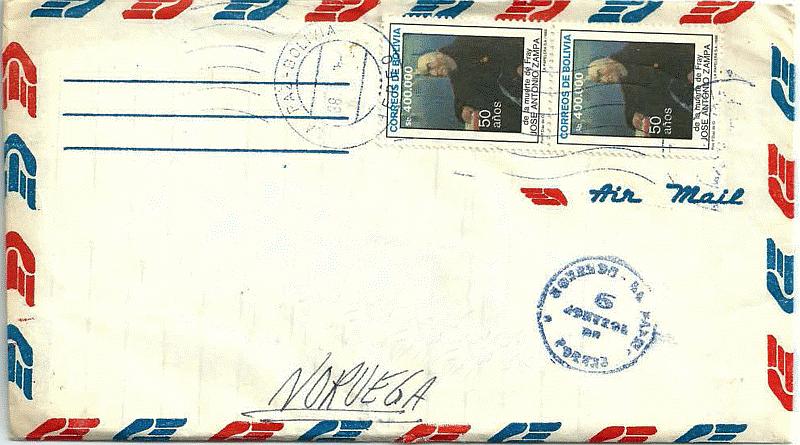
La Paz, 3rd of January 1988
A happy new year to all of you!
I am now sitting in my room boring myself because so much has been closed in La Paz in the last days, and because we were not able to go on our planned Sunday excursion to a place in the north of the country – the buses were full. In addition we have to stay longer here in the city that originally planned causing changes to the entire Bolivia travel schedule. We had in our thoughts to go to a town in the south of the country but as there is only one train a week to Chile (Fridays) we have decided to go there already on the upcoming Friday instead of staying another week in Bolivia.
We are looking forward to get to Chile – especially since Bo is so fascinated by the country and wishes to spend as much time as possible there.
The reason why we do not have time to visit other parts of the country is that Bo had to call on a doctor due to her weak health. She had to take various tests and is not finishing doing that until Monday (tomorrow). A prolonged stomach infection resulting in nausea and diarrhoea has led to her body loosing much of its energy. Now she has bought vitamin and iron pills plus the stuff the doctor has and will ordain. We are hoping that gradually improving food and restaurant hygiene in Chile will restore her health fully. I have for my part had some minor troubles now and then, without any dramatic consequences.
.
Well, enough of that and on to some pleasant news. The cookies came here in (very) good shape, i.e. they were intact, aromatic, and homesickness inducing (a little in any case). Thank you, mother! So nice of you to enclose handkerchiefs as Christmas gifts – thanks again.
We picked up the parcel the 29th, exactly 20 days after it had been stamped into the system here in La Paz. You can figure out the shipping period yourself. There was also a letter from father and sister waiting for me, thanks to you. (The letter took six days; 15th to 21st of December.) (…)
We celebrated New Year’s Eve here in town with Champagne and Norwegian Christmas cookies. We also bought some fireworks – fun. There were a lot of Chinese crackers and the like, but by far the same amount of colourful fireworks we are used to at home. That’s not surprising, in South America’s poorest country.
By the way, did you know that the average income in Bolivia is only 2500 NOK (375 US$) a year, and that 60 % either have no accommodation or only a dwelling of inhabitable quality? Despite this the country is expensive to live in, compared to Peru and Ecuador.
I have no idea how people survive. Some don’t – we see many beggars on the pavements and at restaurant tables – some also dragging babies and little children with them. Some kind of circumstances to grow up in! Grown-ups chew coca-leaves to quench their hunger, cold and despair.
.
For our part we hardly get a dinner for less than 15 NOK (2 USD), compared to half the cost in Peru and Ecuador. We’re paying around 22 NOK (3 USD) each for our hotel room, the double the standard rate in the same countries. It was quite a shock coming here after two months of cheap living. But we manage.
Before coming to La Paz we stayed at couple of days at Lake Titicaca, at 3800 metres. There was no swimming opportunity for me, something I had hoped to do back in Norway. But we went on a boat trip to an island where colourful and pleasant Indians climb up the slopes carrying more rocks up on stone fences and terraces than there are on the entire Jæren.
Out on the large lake there are still some families living on islets of half rotten smelling reed making a living of fishing from their reed boats (and selling souvenirs to tourists).
On the highlands (Altiplano) from Cuzco to La Paz the Indians herd sheep, llamas and alpacas. It is exciting to watch these flocks grassing on the enormous plains. I bought myself a sweater of the super warm and soft alpaca wool (a relative of the llama).
It was fun talking a bit to you on the phone from Cuzco. There wasn’t much that could be said in three minutes, but basically that is not what counts. Till the next time we talk, you can send letters to Santiago.
Read more
The next chapter: Our next few days in La Paz were actually quite lazy with little happening.
Read the introduction to this journey
View a full screen map of the journey

